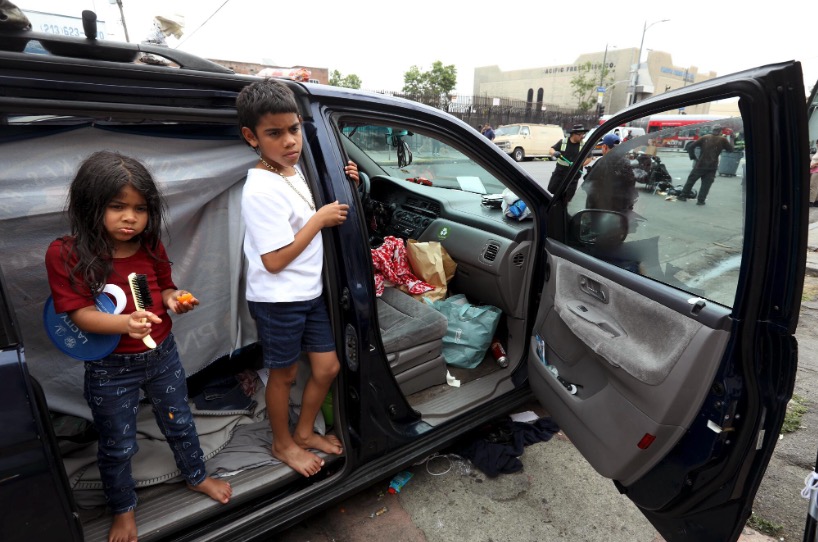Comments
iAUDIT! – On August 25, LAist published an article on family homelessness. It is heartbreaking. While LAHSA claims overall homelessness has decreased, homelessness among families has increased, and there is no longer shelter space for many of them. What makes the story more tragic is that it describes a wholly preventable crisis. As I and others have been saying for a very long time, local homelessness solutions are mired in failed 30-year-old policies designed to help a population that no longer exists. Now we're reaping the poisoned fruits of that misdirection. While LAHSA and other agencies waste billions sheltering and housing the same people over and over again, families are being turned away.
Despite claims to the contrary, limited funding is not the cause for a lack of family housing. As I showed in a CityWatch column last year, the cash and real property assets of the largest nonprofits have skyrocketed, along with CEO compensation. But the facilities they've acquired, besides being managed like medieval madhouses, are not set up to handle families. Homelessness programs are--theoretically--designed to help individuals who need support. Because those services do not match the reality of today's homeless population, with high incidences of untreated mental illness and substance abuse, they are largely ineffective, with some evidence they make things worse. And let's not forget, despite budget reductions from the state and US governments, Measure A is projected to pump $1 billion into the homelessness system--again aimed at the wrong programs because funding is controlled by the same people who claim they're going broke.
The LA City Controller’s 2022 Measure HHH audit shows us how local government has failed unhoused families. The audit report noted construction of HHH-funded units averaged close to $600,000 each and takes three to six years to complete. Eighty-seven percent of the units built or planned were small one-bedroom or studio apartments. Besides being overpriced for the type of unit, they are not suitable for housing families. Inside Safe, the Mayor’s signature homelessness program, has spent more than $450 million to house 1,144 people. Again, the program is not designed to assist families; Inside Safe places individuals in motel rooms, which cannot accommodate families. So, even if there was sufficient shelter capacity for families, there would be no place to house them.

Measure HHH and Inside Safe are just two examples of a homelessness system that is out of sync with its client population. Recent surveys show homelessness is growing among senior citizens and families, yet most programs are focused on individuals. Many of those individuals are bedeviled by chronic substance abuse or untreated mental illnesses, so when they are placed in shelter or housing, they often have experience behavioral problems that get them removed. Investigative reporter Sam Quinones’ article on the Riverside Bridge Home is indicative of the drug abuse, violence, and property crime endemic in LA’s poorly managed shelters. We can hardly expect senior citizens, children, and at-risk women to enter shelters that cannot guarantee their safety.
And yet advocacy groups continue to insist homelessness is purely a matter of affordability, ignoring the reality of the opiate and methamphetamine epidemics among the unhoused. Their efforts to protect the “personal agency” of people with serious untreated mental illness has done little more than assure many people remain locked in the prison of their own minds, or as State Senator Susan Talamantes Eggman said in 2023, “We see real examples of people dying every single day, and they’re dying with their rights on.” Because advocates and public agencies refuse to address causes other than affordability, we now see the sad spectacle of senior citizens and young children joining troubled souls on our streets, in shelters, and in housing.
This is a problem infecting the entire shelter/housing system. For example, a few couples may be “housed” in one of the many tiny home projects throughout the city. Last year, I wrote about the horrendous conditions in LA’s shelters. Conditions in tiny home villages are no better. An investigative report published in the L.A. Public Press in March 2025 described the often-brutal environment people in tiny homes are forced to live in. Residents have endured lack of running water, flooding, verbal abuse from staff, open drug use, and psychotic breaks from other residents. This is in addition to a general lack of maintenance and repairs and dealing with uncaring staff in a state of constant turnover. Of course, these are things we’ve seen in shelters and in other housing modes. In June I described the lack of basic maintenance in a downtown housing facility. So, it should come as no surprise tiny villages are equally mismanaged. Even if unhoused families had a place to go, those places would likely be unsafe and unsanitary.
The LAIst article is both heartrending and infuriating. Families who truly need help find themselves stranded on the street while government agencies and nonprofits spin their wheels providing ineffective services to a population that endlessly cycles through the system. If this doesn't scream out for the need for reform, what does?
(Tim Campbell is a longtime Westchester resident and veteran public servant who spent his career managing a municipal performance audit program. Drawing on decades of experience in government accountability, he brings a results-driven approach to civic oversight. In his iAUDIT! column for CityWatchLA, Campbell emphasizes outcomes over bureaucratic process, offering readers clear-eyed analyses of how local programs perform—and where they fall short. His work advocates for greater transparency, efficiency, and effectiveness in Los Angeles government.)

















